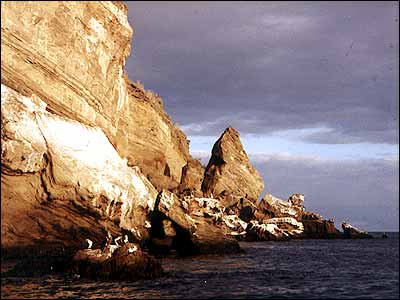The Peripatetic Family

Olivier Lemaigre, a fund manager at Citigroup, grew up in Paris, accumulating more passport stamps than most diplomats. His wife, Jennifer, meanwhile, nurtured the aching kind of travel bug that afflicts kids who grow up bored in the Midwest. Now they’re passing their wanderlust on to their kids: Alex, 11, and Claire, 9. As a family, the Lemaigres have skied from Beaver Creek to Whistler and suntanned from Bermuda to the Côte d’Azur. But on a recent trip to Australia, “we slept on a sailboat—Alex and Claire got to sail it themselves,” says Jennifer. “In the Outback, we bumped into a rare black wallaroo.” What they’ve learned is, the farther afield they go, the more the kids have fun.
The Trip

Photograph by Rob Howard
There are two phrases that any sane traveler dreads above all others: “It’s an educational trip” and “It’s great for kids.” Incredibly, both are true of the Galápagos, an archipelago of volcanic islands 600 miles off the coast of Ecuador, yet most reasonable people still place it high on their trip-of-a-lifetime lists. Jaded types could argue it’s a cliché, but much like the Grand Canyon, the Great Wall, or the Louvre, it’s a destination everyone’s familiar with for a reason: It’s worth it.
In 1835, Charles Darwin visited the Galápagos, an encounter that inspired his theory of “descent with modification,” better known as the theory of evolution. Owing to their splendid isolation, equatorial weather, and amazing wildlife (much of it endemic to the islands), the Galápagos are an ideal laboratory for the study of how evolution works, which is why biologists and naturalists flock there to this day.
A trip there is first and foremost a crash course in evolutionary theory, so it’s a safe bet you won’t run into Senator Rick Santorum. And that’s not the fun part. Like a safari, the Galápagos are about encountering wild animals. But unlike Africa—or anywhere else, for that matter—the birds and reptiles and sea life on these fifteen remote islands have never known any predators, a one-of-a-kind situation that has left them utterly unafraid not only of each other but also of humans.
Walk right up to the animals and they don’t run, fly, or swim away, as early visitors discovered to their amazement. Darwin wrote of pushing birds off branches with the barrel of his gun, and members of our group who arrived armed with long telephoto lenses discovered that they too were unnecessary: The animals here are always ready for their close-up.
Since the islands are accessible only by ship, a Galápagos trip is essentially a cruise. One of the best-run operations is Lindblad Expeditions, whose 238-foot MS Polaris cruises year-round. But this is not your ordinary Caribbean-style party boat. There are only 80 passengers, and instead of cruise directors, there are trained naturalists who lead trips onto eight of the islands. Gambling nights are replaced by science lectures and documentaries, and instead of generic cruise food, there are excellent meals with an Ecuadorean accent.
On our first full day aboard, we woke up off the coast of Española, the southernmost island in the group. A motor-powered Zodiac deposited ten of us on the shore, where dozens of friendly sea lions and hundreds of indifferent marine iguanas were lolling on the rocks. During the hike across the hot, dry island, we walked through a group of nesting blue-footed boobies. Later, my kids and I watched several large albatrosses as they performed their long and hilariously ornate mating dance. (One memorable part involved a herky-jerky step that resembles a drunken sailor’s trying to negotiate a straight line.) I looked it up in the ship’s library that night, and it was clear that witnessing the dance at such close range was an experience much coveted by hard-core naturalists. It was the kind of experience that turns an impressionable young child into a lifelong naturalist—and this was only the first day.
The heart of the trip is the hiking and snorkeling. Zodiacs ferried us to each island to explore their distinctive ecologies. The hikes were awesome. The animals are so approachable they don’t seem real at first, as if some Disney World technician had installed thousands of animatronic creatures on a papier-mâché volcano. But for the children, it was the snorkeling that blew their collective minds. They’d never dreamed they’d be swimming among sea lions or chasing penguins as the giddy birds gorged on swirling schools of silver baitfish.
The most unforgettable moment for my son George, 11, was while we were snorkeling alone together off Genovesa Island. We had been watching some penguins and brightly colored parrotfish when George suddenly grabbed my arm and let out an underwater yelp. He was pointing frantically at a gigantic black-and-white creature undulating toward us. We froze as it slowly swam past and remembered at the last second to snap a picture with our underwater camera. At first I thought it might be a hammerhead shark, but spluttering to the surface, George insisted it was a manta ray, which can have a wingspan of up to 25 feet.
The naturalists on the beach were convinced we had seen a smaller eagle or diamond ray. “But it was so much bigger,” George insisted. No one believed us, but George stuck to his guns. Two weeks later, when we got the film back, there it was: a single shot of a huge manta ray, clearly identifiable, swimming away from the camera. George had his evidence. His theory had become fact. The Galápagos had made a scientist of him, too.
Ten-day cruises of the Galápagos Islands aboard Lindblad Expeditions’ MS Polaris start at $3,480 for double occupancy, and include everything from meals to snorkeling equipment and wet suits (800-762-0003 or expeditions.com).